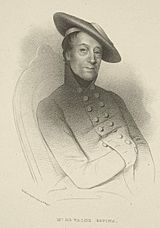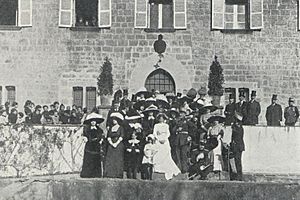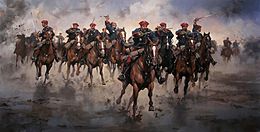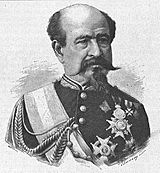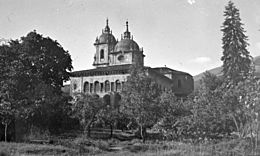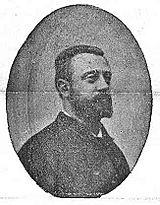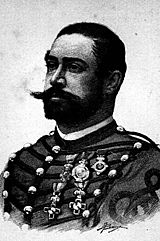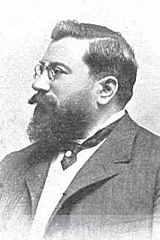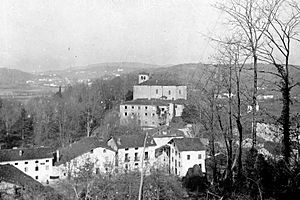José María de Orbe y Gaytán facts for kids
Quick facts for kids
José M. de Orbe y Gaytán
|
|
|---|---|
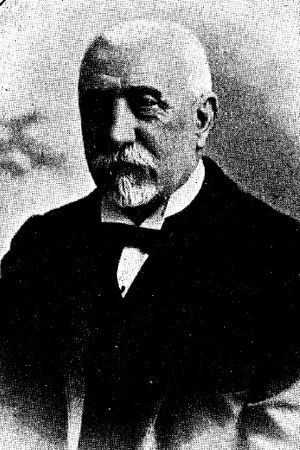 |
|
| Born |
José María de Orbe y Gaytán de Ayala
1848 |
| Died | 1933 (aged 84–85) |
| Nationality | Spanish |
| Occupation | landowner |
| Known for | politician |
| Political party | Carlism |
José María de Orbe y Gaytán de Ayala, 5th Marquess of Valde-Espina, 1st Viscount of Orbe (1848-1933) was a Spanish Carlist soldier and politician. He was part of the Carlist movement, which supported a different branch of the Spanish royal family. His most important role was leading the local government of Gipuzkoa (a region in Spain) in the 1910s. He is also famous for being a member of the well-known Valde-Espina family from the Basque region. Within the Carlist party, he became a leader in Gipuzkoa and was briefly part of the national leadership.
Contents
Family and Early Life
José María came from an old noble family in the Basque Country. The Orbe family started in a small village in Gipuzkoa. Later, they moved to Ermua in Biscay. They became very important in the mid-1700s. This happened after they built a grand palace and one of their family members, Andrés de Orbe y Zarauz, became the first Marquess of Valde-Espina. The family also became richer by marrying into the Murguía y Arbelaiz family. This family owned many lands in eastern Gipuzkoa, especially around a large house in Astigarraga.
José María's grandfather, José María de Orbe y Elío (1776-1850), inherited a lot of wealth. He owned 30 estates in Biscay and many more in Gipuzkoa. He was a general and fought in several wars. He lost an arm during the War of the Pyrenees. He was also against the 1812 Spanish Constitution, which almost cost him his life. During the First Carlist War, he joined the Carlists and became their minister of war. He died in exile in France.
José María's father, Juan Nepomuceno de Orbe y Mariaca (1819-1891), was the 4th Marquess. He also fought in the First Carlist War under his father. He was wounded twice. He later took part in Carlist plots in 1848 and 1860. During the Third Carlist War, he was a chief of staff and led cavalry charges. After a short time in exile, he returned to Spain. He was already a hero among the Basque Carlists. He married Casilda Gaytan de Ayala y Areizaga (1824-1881), who also came from a noble Gipuzkoan family. They lived in their family homes in Ermua and Astigarraga. José María was their older son.
José María first studied at home. In the late 1850s, he went to the Jesuit Tivoli college in Bordeaux, France. He studied there for several years. Later, he moved to a school in Pamplona, where he finished his high school studies in the mid-1860s. Some records say he also attended other schools in Vergara and Madrid.
José María married María Vives de Cañamas (1853-1910) from Valencia. Her father was the 18th Count of Almenara. José María and María had seven children between 1879 and 1894. None of them became famous public figures. Their oldest son, Ignacio de Orbe y Vives Cañamas, became the 6th Marquess. He was somewhat involved in the Carlist movement in the 1960s. José María's great-grandson, José María de Orbe y Klingenberg, is a filmmaker. His movies are often set in Catalonia. One of his recent films was partly filmed in the Astigarraga palace and hints at his family's history.
Fighting in the Carlist Wars (1868-1876)
Given his family's strong Carlist background, José María was expected to join the Carlist cause. In 1868, he moved to France with his father and younger brother. They planned another uprising. José María returned to Spain shortly after. He was involved in a failed attempt to start a rebellion in Navarre called La Escodada. He then fled back to France in 1870.
In 1872, he joined the Carlist uprising in Gipuzkoa as a cavalry lieutenant. His first fight was on May 14, near Mañaria, when Carlist troops were already retreating. Two days later, during battles at Oñate, his horse was shot twice. He managed to escape to France later that month.
In early 1873, Orbe entered Spain again. He was assigned to his father's units, which had taken control of southern Gipuzkoa and were moving towards Biscay. On March 3, he fought in battles near Marquina-Echevarria and then moved to Guernica. In April, his cavalry unit traveled across Gipuzkoa and Álava to Navarre. They fought in areas like Oñate, Azcárate, and San Vicente-Peñacerrada. They also fought at Eraul on May 5.
After this, he commanded a group controlling the Baztan Valley. In July 1873, he welcomed the Carlist leader, Carlos VII, back to Spain at Zugarramurdi. José María became Carlos VII's adjutant general. During the summer, he helped the Carlists take over central Navarre. He was involved in battles at Ibero, Las Campanas, Estella, Allo, Dicastillo, and the siege of Viana. In early November, he successfully pushed back a government attack near Montejurra. In early 1874, he moved back to Biscay and took part in the siege of Bilbao. In March, he was given the important job of handling the Carlist war flag, La Generalísima. Soon after, Orbe helped defeat enemy troops at Somorrostro.
He was promoted to capitán (captain) and received awards. In the spring of 1874, Orbe was tasked with organizing the journey of the Carlist queen, Doña Margarita, from Pau to Estella, the Carlist capital. He planned a secret trip using trains and coaches to trick the French authorities. His plan worked, and in the summer, Doña Margarita arrived in Estella via Dancharinea.
In the fall of 1874, he was sent to fight in Gipuzkoa. This mostly involved failed sieges of Irún and Guetaria. Back in Navarre in early 1875, he fought in the battle of Lacár in February. He was promoted to comandante (major) and received more awards. In the summer of 1875, he joined Carlos VII during the "Jura de Los Fueros" (oath to ancient Basque laws) in Guernica. From then on, Orbe stayed as part of Carlos VII's personal guard and did not fight on the front lines. In February 1876, as he accompanied Carlos VII to the French border, he was promoted to lieutenant colonel and given the title of Viscount of Orbe. At Valcarlos, Orbe crossed the border with Carlos VII and chose to join him in exile.
After the War: In His Father's Shadow (1876-1891)
Orbe went with his king to Bordeaux and then to London. Carlos VII seemed to enjoy his company and wanted Orbe to join him on a trip to America. However, Orbe asked for permission to leave, as he planned to get married. He got permission, married, and settled in Saint-Jean-de-Luz, France. In 1877, his public activity was limited to sending letters supporting various Traditionalist groups.
It is not clear when he returned to Spain. His first child was born in 1879 in Ermua, Spain. His father returned in 1880 and immediately took a leading role for the Carlists in the Basque Country. José María was not well-known for anything other than his wartime actions, his famous family, and letters he published in newspapers. He relied on his father's popularity when he ran in local elections for the Biscay provincial council from Durango in 1883. He seemed to win, but his election was canceled for legal reasons.
At that time, the Carlist groups in the Basque Country were disorganized. It was hard to rebuild them. Because there were few recognized leaders and others were not interested, Orbe was considered to lead the entire Biscay Carlist organization in 1884. However, this plan was dropped. Similarly, in 1886, he was supposed to lead the Marquina district, but this also did not happen. His father, who was the official Carlist leader for the whole Basque Country, was still trying to rebuild the party. Due to small conflicts in the Biscay branch, Orbe was again asked to be a candidate for the provincial council in 1886, this time from Guernica. After what seemed like a successful campaign, he was again disqualified.
In 1887, José María spent most of his time with Carlos VII during another trip to America. It's not clear if Orbe visited all the places with him, like Haiti, Barbados, Jamaica, Panama, Chile, Uruguay, and Brasil. He was definitely recorded in Buenos Aires.
In the 1880s, the Carlist movement was split between supporters of Nocedal and supporters of the Carlist king. The Orbe family clearly supported the king. When the Circulo Católico Vascongado, a Carlist front organization in Biscay, was taken over by Nocedal's supporters, their opponents started a new group called Sociedad Tradicionalista. In 1887, Orbe joined its Biscay leadership. After the Integrist split in 1888, he continued to work to rebuild loyal Carlist groups. He became the leader of the Marquina district, though its organization was mostly on paper.
His third attempt to run for the provincial self-government was successful. He was elected from Guernica and served as a member of the Biscay Provincial Council from 1889 to 1890. He finally gained a recognized political position. He stepped out of his father's shadow when he became the alcalde (mayor) of Ermua in 1891, succeeding his father. After his famous father's death, José María was officially confirmed as the 5th Marquess of Valde-Espina in 1892.
Less Active in Politics (1891-1904)
While helping his father in the 1880s, Orbe stayed involved in Carlist politics at both regional and national levels. This changed after 1891. With new Carlist leaders appointed in Gipuzkoa and Biscay, and a regional leader for the Basque Country, the new Marquess of Valde-Espina became less involved in major party politics. His term on the Biscay Provincial Council ended, and he did not hold other public jobs, though it's unclear when he stopped being mayor of Ermua.
From 1892 to 1895, his political activities were limited. He attended party meetings, signed public letters, and occasionally spoke at local gatherings. He also led formal dinners. Although he didn't run in elections, he helped organize Carlist election efforts. At this time, he seemed involved in both Biscay and Gipuzkoan issues, but perhaps more in Biscay. In the mid-1890s, he was reported to be forming alliances for the provincial council, especially in the Marquina district.
By the end of the 1890s, it seemed his younger brother, Candido de Orbe y Gaytán, was becoming more active in politics. Candido also attended Carlist events and gave official press statements. He became the leader of the San Sebastián branch. He was very involved in creating an election alliance with the Integrists. This alliance ended a decade of strong disagreements and started a new friendship between the two branches of Traditionalism across Spain.
Valde-Espina himself remained less prominent. In 1898, there were rumors he would run for the Spanish Parliament, but this was false. We don't know his thoughts on Carlist plans for another uprising between 1898 and 1900. However, his house in Astigarraga was searched by the police and briefly taken over. After La Octubrada (a Carlist uprising in 1900), he oversaw the forced closing of Carlist clubs in Gipuzkoa.
In the early 1900s, Valde-Espina continued to focus his activities on the Basque Country. He was not reported to be involved in major national party politics. Unlike his father, he was never very close to the former Carlist leader, the Marquess of Cerralbo. He was also not part of the political group around the next leader, Matías Barrio y Míer. However, he always remained on excellent terms with the Carlist king and on good terms with the Gipuzkoan provincial leader, Olazábal.
It seems that at this time, his focus shifted from Biscay to Gipuzkoa. He lived mostly in Astigarraga, where he became the mayor, and the Ermua palace remained empty. Historians also suggest that his role, which was typical for many Carlist noble leaders in the Basque Country, was to gather support from people in rural areas. This was mostly effective in Gipuzkoa, but much less so in Biscay, where Carlist influence was already declining greatly.
Rising in the Party (1904-1911)
In 1904, several politicians from center-right parties formed Liga Foral Autonomista. This group aimed to bring back special local laws for Gipuzkoa. Candido de Orbe, José María's brother, became its vice-president and later its president. Valde-Espina joined this group as an official Carlist representative. He signed its public statement, joined its leadership council, and helped plan a joint election campaign.
However, the Carlist leaders became suspicious that the Integrists were too dominant in the alliance. Valde-Espina was made to resign from the leadership council. He stayed in the Liga as an ordinary member, saying that "every good Basque" should keep supporting it. This situation led to rumors about problems within the official Carlist party in Gipuzkoa, but these rumors turned out to be exaggerated. Valde-Espina remained active in the Liga until it broke apart in 1906.
Despite the controversy over his Liga membership, Valde-Espina's career in the party grew. In 1907, he took over from his brother as the leader of the Carlist groups in San Sebastián. In 1908, he replaced Tirso Olazábal as the Carlist leader in Gipuzkoa. In 1909, as a provincial leader, he automatically joined the national Carlist leadership, the Junta Central. His public presence became more noticeable. He appeared prominently at large Carlist meetings in Somorrostro and Zumarraga.
Although he had always favored working with the Integrists, the new Carlist party leader, Bartolomé Feliú, made him take strict action against those who went too far with election alliances. This led to the expulsion of Víctor Pradera from the party. Still, in 1910, Valde-Espina invested money in a publishing company called Sociedad Española de Edificaciones y Publicidad. He also joined its board of directors. This new company was set up to support Carlist and allied newspapers and publications. He remained on the board for many years.
Around 1910, Catholic public opinion was very upset about the "Ley del Candado" (Lock Law). This was a Liberal law promoted by the Canalejas government that was tough on the Church. Valde-Espina represented the Carlists in several groups formed to block this law, such as the Junta del País Vasconavarro and the Junta de Defensa Católica de Vizcaya. Because of his more aggressive public stance, he also faced administrative actions. After a press statement he made was considered to disturb public order, he was suspended as mayor of Astigarraga in 1910. He had held this job since the early 1900s. The same year, his activities caught the attention of the Spanish Parliament, which demanded explanations about propaganda efforts featuring the new Carlist king, Don Jaime. Following family tradition, he was also introducing a new generation of Orbes into Carlist politics at this time, as his oldest son Ignacio began appearing at various meetings.
Leading Gipuzkoa (1911-1922)
In 1911, Valde-Espina ran again for the provincial self-government, this time for the Provincial Council of Gipuzkoa. He won in the Irun district. Later that year, he became the president of the entire council. Progressive newspapers complained that "the leader of the civil war, the Marquess of Valdespina, is president of the Gipuzkoa council." However, Carlists celebrated his triumph. They were probably less happy about Valde-Espina meeting the reigning king, Alfonso XIII, either in the province or in Madrid.
He remained head of the provincial government in 1911, 1912, and 1915. In 1915, he failed to get re-elected from Tolosa. His time in office was not marked by much controversy. Perhaps the only exception was a conflict over a new railway line. Some thought it favored the interests of Navarre and Álava at the expense of Gipuzkoa. He mostly handled regular administrative duties. He also aimed for more independence for provincial education departments.
Although he was not very involved in national party politics in the 1910s, Valde-Espina was a well-known figure among Carlists. He was named honorary president of various groups, even as far away as Murcia. People called him "veteran marquess" or "illustrious patrician." He received honors and was deeply moved when remembering his wartime service to Don Carlos 40 years earlier. His mansion in Astigarraga became an important Carlist meeting place, hosting gatherings and important guests.
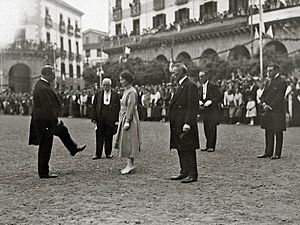
A disagreement grew between the main Carlist writer, Juan Vázquez de Mella, and the new king, Don Jaime. Don Jaime trusted Valde-Espina. He unsuccessfully demanded that de Mella give ownership of the party's newspaper, El Correo Español, to Valde-Espina.
In 1917, Valde-Espina ran again for the Gipuzkoan council and narrowly won from Irun. He was re-elected two years later. He stayed in the self-government until 1922, serving as president at times, for example, in 1918 or 1919. His second term was mostly focused on the Basque question and the legal status of the Basque Country. In 1917, he attended a meeting called Asamblea de Victoria. This was a gathering of provincial deputies from the region who demanded "broad autonomy." He likely made similar demands with colleagues from other Basque-Navarrese councils when meeting Alfonso XIII in 1918 or sending telegrams to Madrid.
Some of his statements seem confusing. Also in 1918, he left the regional platform and stated that Gipuzkoa expected the same level of self-government as Catalonia. He officially supported the launch of the Society of Basque Studies and contributed to its work. However, he strongly opposed Basque nationalist political goals. Within the Carlist movement, as the Gipuzkoan leader, he also supported initiatives pushing for regional rights, though the term "autonomy" was used carefully, often in quotation marks.
Party Split and Later Life (1920s and 1930s)
Valde-Espina had known Juan Vázquez de Mella since the early 1900s and met him at various party meetings. However, he wasn't known to be particularly fond of the main party writer. Still, his tendency to form alliances with conservative groups might have made him closer to de Mella's idea of creating a large ultra-Right coalition. Also, during the Great War, Valde-Espina supported a neutral stance, which was also strongly advocated by de Mella.
When the conflict between de Mella and the Carlist king Don Jaime exploded in early 1919, the Gipuzkoan leader initially took an unclear position. But by spring, he was widely suspected of joining de Mella's breakaway group. Indeed, after 85 years of loyalty from three generations of Valde-Espinas to the Carlist kings, José María left the main Carlist party and joined the rebels.
Because of his position and his family's prestige, Valde-Espina was one of the most important figures among de Mella's followers. However, likely due to his age, he was not very active in building the new party. The times when his family name could gather widespread popular support were long gone. Historians believe that any moderate support the breakaway group had among rural people in Gipuzkoa was not really due to his personal influence.
He was given a mostly symbolic role as provincial leader in the new party. He helped prepare for a large meeting that was supposed to launch a new national organization. This meeting happened in 1922 in Zaragoza, though not exactly as de Mella had planned. The gathering launched the Traditionalist Catholic Party, and Valde-Espina was named president of its national executive committee. In late 1922, he signed documents issued by the party and was active in its ranks in early 1923.
The Primo de Rivera coup (a military takeover) stopped all political life by banning all parties. This year marks Valde-Espina's final retirement from politics. After this, he was rarely recorded as politically active.
During the dictatorship, Valde-Espina mostly focused on charity in public. His last recorded political activities were in the early 1930s. During the dictablanda (a softer dictatorship), he signed an appeal from Euskaltzaindia (the Royal Academy of the Basque Language) to start discussions on Basque autonomy. The same year, he somewhat reconciled with the Carlists. In August, he was present at the opening of a Carlist club in San Sebastián. In 1931-1932, he fully rejoined the united Carlist organization, Comunión Tradicionalista. Despite being 84 years old, he was still suspected of plotting against the Republic. In 1932, his Astigarraga estate was raided by the police again. He was last noted taking part in a Carlist gathering in July 1932 in Villafranca.
He caught a cold during his younger son's funeral in February 1933 and spent the last four months of his life in bed. At the time of his death, the Astigarraga mansion was again seen as an important Traditionalist site. Also, Ermua was one of the few towns in Biscay that continued to resist the growing influence of Basque nationalism.
See also
 In Spanish: José María de Orbe y Gaytán de Ayala para niños
In Spanish: José María de Orbe y Gaytán de Ayala para niños
- Carlism
- Traditionalism (Spain)
- Mellismo
- José María de Orbe y Elío
- Juan Nepomuceno de Orbe y Mariaca


